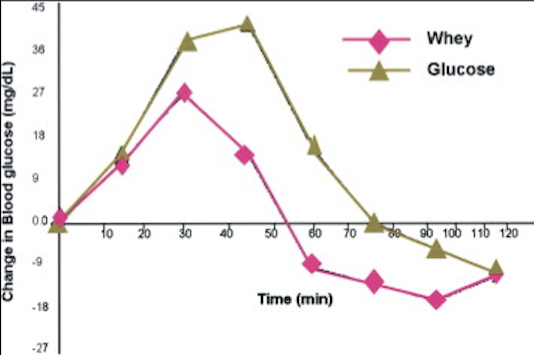Exercise and Protein Supplements
Introduction[edit | edit source]
Types of Protein Supplements[edit | edit source]
Soy protein supplementation has had a lot of controversy over its effect on musle through use with resistance training, but also the postives and negatives of some of its potential side effects. The main content of soy protein supplements is the soy bean. In a 2006 study, the effects of whey and soy protein with resistance training young men and women in comparison to a blinded control group. The results showed that soy protein in combination with resistance training produces the same effects as whey protein supplementation. [1]
How protein metabolizes and protein's effects on the body[edit | edit source]
Timing of protein supplementation[edit | edit source]
In one study researchers investigated the impact of amino acid (lysine, proline, alanine, and arginine) and/or conjugated linoleic acid (CLA) supplements administered before and after aerobic exercise on body weight, percentage body fat, waist and hip circumference, triglycerides and LDL-cholesterol levels [2]. When compared to the placebo group, the waist and hip circumference and BMI of the experimental group after aerobic exercise was a clinically significant.
Types of exercise and protein supplementation[edit | edit source]
Age and the affects of protein supplementation[edit | edit source]
Gender and the affects of protein supplementation[edit | edit source]
Additional Side Effects[edit | edit source]
In addition to its effects on muscles, the use of protein supplements may also come with a number of other side effects, both chronic and acute. Several studies have shown that increased protein intake through the use of protein supplements can have the effect of lowering both systolic and diastolic blood pressure. Its use may therefore be beneficial in managing the blood pressure of those with hypertension. However, one needs to exercise caution with protein supplementation for those whose blood pressure is already low or who are taking medication that lowers blood pressure, as it may increase hypotension-related risks.[3][4][5][6][7]
Because protein intake also causes an increase in blood insulin levels, studies have shown that it can significantly lower blood sugar levels. This effect is most pronounced following the ingestion of whey protein, but is still noticeable with the ingestion of protein from other sources.[8][9][10][11] The following graph is from a study comparing blood glucose levels after ingesting a plain glucose drink with blood glucose levels after ingesting the same glucose drink mixed with whey protein[12]:
Blood glucose levels were clearly much lower when whey protein was ingested. It is therefore important to be mindful of this effect on blood sugar levels when one already has low blood sugar or when one may be taking insulin for diabetes. Failing to do so could potentially increase dangerous hypoglycemia-related risks.
Conclusion[edit | edit source]
References [edit | edit source]
- ↑ Candow DG, Burke NC, Smith-Palmar T, Bure DG. Effect of whey and soy protein supplementation combined with resistance training in young adults. International Journal of Sport Nutrition and Exercise Metabolism 2006; 15:233-244. Full version: http://journals.humankinetics.com/AcuCustom/Sitename/Documents/DocumentItem/5956.pdf (accessed 19 Nov 2006).
- ↑ Michishita, T., Kobayashi, S., Katsuya, T, Ogihara, T., Kawabuchi, K. (2010). Evaluation of the antiobesity effects of an amino acid mixture and conjugated linoleic acid on exercising healthy overweight humans: A randomized, double-blind, placebo-controlled trial. Journal of International Medical Research, 38, 844-859.
- ↑ Nussberger J. (2007). Blood pressure lowering tripeptides derived from milk protein. Therapeutische Umschau, 64(3), 177-179. doi:10.1024/0040-5930.64.3.177
- ↑ Pal, S., Ellis, V. (2010). The chronic effects of whey proteins on blood pressure, vascular function, and inflammatory markers in overweight individuals. Obesity (Silver Spring), 18(7), 1354-1359. doi:10.1038/oby.2009.397
- ↑ He, J., Wofford, M., Reynolds, K., Chen, J., Chen, C., Myers, L., . . . Whelton, P. (2011). Effect of dietary protein supplementation on blood pressure: A randomized, controlled trial. Circulation, 124(5), 589-595. doi:10.1161/CIRCULATIONAHA.110.009159
- ↑ He, J., Gu, D., Wu, X., Chen, J., Duang, X., Chen, J., & Whelton, P. (2005). Effect of soybean protein on blood pressure: A randomized, controlled trial. Annals of Internal Medicine, 143(1), 1-9. doi:10.7326/0003-4819-143-1-200507050-00004
- ↑ Teunissen-Beekman, K., Dopheide, J., Geleijnse, J., Bakker, S., Brink, E., Leeuw, P., & Baak, M. (2012). Protein supplementation lowers blood pressure in overweight adults: Effect of dietary proteins on blood pressure (PROPRES), a randomized trial. American Journal of Clinical Nutrition, 95(4), 966-971. doi:10.3945/ajcn.111.029116
- ↑ Pal, S., Ellis, V. (2010). The acute effects of four protein meals on insulin, glucose, appetite and energy intake in lean men. British Journal of Nutrition, 104(8), 1241-1248. doi: http://dx.doi.org/10.1017/S0007114510001911
- ↑ Frid, A.H., Nilsson, M., Holst, J.J., & Bjorck, M.E. (2005). Effect of whey on blood glucose and insulin responses to composite breakfast and lunch meals in type 2 diabetic subjects. American Society for Clinical Nutrition 82(1), 69-75.
- ↑ O’Keefe, J.H., Gheewala, N.M., & O’Keefe, J.O. (2008). Dietary Strategies for Improving Post-Prandial Glucose, Lipids, Inflammation, and Cardiovascular Health Journal of the American College of Cardiology, 51(3), 249-255. doi:10.1016/j.jacc.2007.10.016.
- ↑ Petersen, B.L., Ward, L.S., Bastian, E.D., Jenkins, A.L., Campbell, J., & Vuksan, V. (2009). A whey protein supplement decreases post-prandial glycemia. Nutrition Journal 8(47). doi: 10.1186/1475-2891-8-47
- ↑ O’Keefe, J.H., Gheewala, N.M., & O’Keefe, J.O. (2008). Dietary Strategies for Improving Post-Prandial Glucose, Lipids, Inflammation, and Cardiovascular Health Journal of the American College of Cardiology, 51(3), 249-255. doi:10.1016/j.jacc.2007.10.016.







